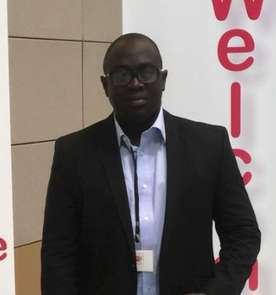An interview with Eric Bediako [Promoted]
Prior to the 10th Chem/Petrochem and Refinery Asset Reliability Conference, we spoke with Eric Bediako, Reliability Engineering Superintendent at the Delek US Holdings El Dorado Refinery in Arkansas. Eric has 13 years of industrial experience in various roles in refining and industrial gases and a doctoral student in the Department of Industrial Engineering at Texas Tech University. He earned his master’s degree in systems and engineering management at Texas Tech University and earned his bachelor’s degree in Chemical engineering at the Kwame Nkrumah University of Science and Technology. His research includes stochastic approach to piping degradation and maintenance optimization using Markov Decision process.
What is one of the most important lessons you’ve learned from working with NDE methods to identify problems with fixed equipment?
|
Advertisement: The National Gas Company of Trinidad and Tobago Limited (NGC) NGC’s HSSE strategy is reflective and supportive of the organisational vision to become a leader in the global energy business. |
The most important lesson I have learned from working with NDE methods is to use the right method for the right damage mechanism or degradation process. In other words using the wrong methods could lead to a type II error, potentially leading to a catastrophic failure.
When is the best time to implement non-destructive examination within a components lifecycle?
I would say the best time to implement NDE is from the initial installation of the components, at the least in the case of piping degradation monitoring. The more the data points, the higher the certainty of prediction of failure.
What it a notable thing that you have found when comparing today’s inspections with the outcomes of older inspection?
The most notable difference I have personally seen in my analysis of data from older inspection methods and relatively current methods is the higher level of accuracy for the latter. Resulting in the comparative readings indicating an increase rather than decrease in wall thickness.
How has the use of continuous ultrasonic testing affected the process of detecting flaws?
Continuous UT thickness measurements add a lot of value to long term planning for replacement. Some of these UT measuring devises log readings every 12-24 hours and with this type of data, you are able to detect aggressive corrosion rates faster than time interval based UT inspections.
What would you like to achieve from attending our 10th Chem/Petrochem & Refinery Asset Reliability Conference?
I hope to share the knowledge I have acquired in programs I have been involved in for refinery equipment reliability and to also learn new ways of doing things in our industry.
Eric is one of our keynote speakers and panelists

Case study:
Implementing Advanced Methodologies in Non-Destructive Examination (NDE) to Identify Problems with Fixed Equipment
•Examining when to use NDE methods within the lifecycle of a component
•Developing useful methods of NDT to structure and microstructure characterization and location
•Exploring developments in HTHA (High Temperature Hydrogen Attack) detection to prevent damage to materials
•Enabling ability to store large data files to compare new inspections with previous inspections
•Usurping inspections with use of automatic ultrasonic testing (UT) to detect and trend flaws
10th Chem/Petrochem and Refinery Asset Reliability
Integrating Structured Reliability Systems to Exceed Mechanical Integrity and Plant Production
21-23 Jan 2020
Houston, TX, United States of America
The 10th Annual Chem, Petrochem & Refining Asset Reliability event will enable you to expand your awareness of solutions and tools used to overcome reliability and asset management challenges, as well as provide you with information essential to improving productivity within your plants and organization. Attendees will acquire proven techniques to administer a sustainable, successful Asset Reliability Program.
Attending this premier marcus evans conference will enable you to
- Assess best practices with integrating reliability and capital projects to reduce operating costs and increase capital
- Valuate innovative and automatic tools to enhance inspection and maintenance processes
- Prioritize work and create a back-log management plan during planning and scheduling to optimize resources
- Implement advanced methodologies in non- destructive examinations (NDE) to identify problems with Fixed Equipment
- Enable the move from Preventative to Predictive Maintenance Models with Real Time Condition Monitoring
- Harness reporting tools for reliability and asset performance management (APM)
Experts include:
- Ernest J. Newmens, CMRP, Maintenance & Reliability Superintendent, Stepan Company
- Richard Crews Large Projects Lead, Shell Pipeline
- Dan Mahoney, Corporate Reliability Leader, HollyFrontier Corporation
- Aaron Quintanilla, Global Reliability Engineer, The Dow Chemical Company
- Earl Crochet, PE, Director of Engineering- Asset Regulatory Support, Kinder Morgan
- Daryl Leggett Maintenance Leader Braskem
- Joshua Dotson, Mechanical Integrity Specialist, Koch Fertilizer
Who Should Attend:
marcus evans invites Plant Managers, Superintendents, and Senior Professionals from Chemical / Petrochemical Plants and Refineries with responsibilities or involvement in:
• Plant Operations / Management
• Maintenance or Reliability Excellence
• Asset Management / Asset Integrity
• Mechanical Integrity/Inspections
• Fixed Equipment / Rotating Equipment
For more information visit the event website.
If you have questions regarding registering for the event, please contact Melini Hadjitheori at melinih@marcusevanscy.com
Disclaimer: The statements, opinions and data contained in the content above are solely those of the individual authors and contributors and not of the publisher and the editor(s) of Natural Gas World



